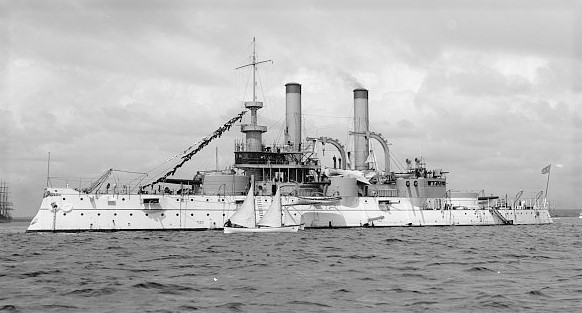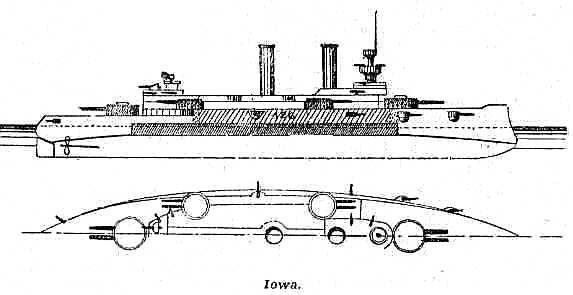
Battleship U.S.S. Iowa
By Patrick McSherry

The U.S.S. IOWA (BB-4) at anchor
Please Visit our Home Page
to learn more about the Spanish American War
An Account of
Danger in Fireroom 2! (Medal of Honor Recipents on the IOWA)
Iowa in drydock
||| An IOWA broadside
painting ||| Chart
of hits recieved by the IOWA in the Battle of Santiago
Click here for Iowa
Crewman Bernard Keegan's account of the Battle of Santiago
Please Visit our Home
Page to learn more about the Spanish American War
GENERAL:
The USS IOWA was the very newest American battleship in the
Spanish-American War. Like the INDIANA class,
IOWA was classified as a "Seagoing Coastline Battleship", but she was a
better sea boat than the earlier battleships. She took part in the Battle
of
Santiago on July 3, 1898.
BACKGROUND:
USS IOWA was assigned to the Atlantic Fleet, and was ordered to blockade
duty off Santiago de Cuba on May 28, 1898. She was the first US ship to
sight Admiral Cervera's Spanish ships coming
out of the channel on July 3, and fired the first shot in the Battle of
Santiago de Cuba. In a 20-minute duel with Spanish cruisers MARIA
TERESA and OQUENDO, IOWA's effective fire
helped set both ships aflame and drive them upon the beach. Later in the
engagement, IOWA joined with INDIANA and GLOUCESTER
in destroying the Torpedo Boat Destroyers PLUTON and
FUROR. IOWA then turned her attention to the Spanish cruiser VIZCAYA
which she pursued until the Spanish ship was run aground and surrendered.
After the battle, IOWA received on board many Spanish prisoners, including
Admiral Cervera and the officers and crews of
the VIZCAYA, PLUTON and
FUROR.
USS IOWA arrived in New York from Cuban waters on August 20, 1898.
That October, she departed for the Pacific, sailing around Cape Horn,
and arriving in San Francisco on February 7,1899. After a refit at
Bremerton, Washington, she conducted training cruises, drills, and
target practice. IOWA left the Pacific early in February 1902 to become
flagship of the South Atlantic Squadron. She sailed for New York
February 12, 1903 where she decommissioned June 30th. She was
recommissioned that December, returned to reserve in July, 1907, and
again decommissioned in July, 1908. IOWA was recommissioned for training
duties from May, 1910 to May, 1914. She was in limited commission for
receiving, training and guardship duties beginning April 28, 1917, and
was decommissioned for the last time on March 31, 1919. USS IOWA was
stricken in 1920, reinstated as IX 6 that same year, and converted to a
radio controlled target ship and sunk March 23, 1923.
ADVANTAGES/DISADVANTAGES:
The major advantage of USS IOWA over the ships of the INDIANA class was
the new battleship's higher freeboard, which made the guns easier to work
in heavy seas. She was not, however, a full-fledged first class battleship
equal to those of Great Britain and other powers. Also, IOWA was of
single-screw design and shipped only 12" main guns, both features were a
step backwards from the INDIANA.
TECHNOTES:

| Classification: |
|
Sea-Going Coast-Line Battleship, BB 4 |
| Keel Laid: |
|
August 5, 1893 |
| Launched: |
|
March 28, 1896 |
| Commissioned: |
|
June 16, 1897 |
| Rig: |
|
One military mast. |
| Armament: |
|
Four 12" guns |
|
|
Eight 8" guns |
|
|
Six 4" guns |
|
|
Twenty 6 pounders |
|
|
Four 1 pounders |
|
|
Four 14" torpedo tubes |
| Contractor: |
|
William Cramp & Sons, Philadelphia, PA. |
| Length: |
|
362 feet, 6 inches |
| Beam: |
|
72 feet |
| Mean draft: |
|
24 feet |
| Normal Displacement: |
|
11,410 tons |
| Displacement Fully Loaded: |
|
12,647 tons |
| Complement: |
|
727 Officers and Enlisted Men, under the command
of Captain Robey D. Evans |
| Engine type: |
|
Vertical triple expansion engines, generating
11,000 hp. Single screw |
| Boiler type: |
|
Five 160 psi boilers. |
| Speed: |
|
17 knots |
| Armor: |
|
4-14" belt, 2.75-3" deck, 12.5-15" barbettes,
15-17" turrets. |
Clerk of Joint Committee on Printing, The Abridgement of Message from
the President of the United States to the Two Houses of Congress.,
Washington: Government Printing Office, 1899. 4 vols. (all are documents
relating to the war)
Gardiner, Robert, Ed., Conway's History of the Ship: Steam, Steel
& Shellfire - The Steam Warship 1815-1905. London: Conway
Maritime Press Ltd., 1992.
Naval History Department, Navy Department, Dictionary of American
Naval Fighting Ships. Washington DC: Government Printing Office,
1959.
Reynolds, Francis J., The United States Navy. New York: P. F.
Collier & Son, 1918
Support this Site by Visiting
the Website Store! (help us defray costs!)
We are providing the following
service for our readers. If you are interested in books, videos, CD's
etc. related to the Spanish American War, simply type in "Spanish
American War"(or whatever you are interested in) as the keyword and
click on "go" to get a list of titles available through Amazon.com.
Visit Main Page for
copyright data



